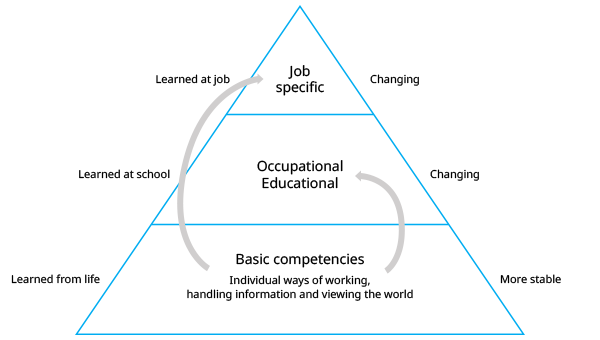< Lessons

Individuals can be viewed with three competence elements arranged in a pyramid-like form. At the peak are JOB SPECIFIC competencies developing from work experience. They are built on EDUCATIONAL and OCCUPATIONAL competencies which derive from formal education. At the base are BASIC competencies ie., individuals' characteristic ways of working, handling information and viewing the world. They develop earlier and are more stable in time and they give direction to all educational, occupational and job specific competence regardless of the person's age, education, work experience or employment status. They derive from individual motivations, ways of thinking and attitudes. They may be described as personified, easily relatable "Experts in work".
The three competency elements are arranged in the order of learning. It all begins with the development of BASIC competencies which give direction to EDUCATIONAL and OCCUPATIONAL competence, which give direction to JOB SPECIFIC competence. As more stable structures they give constant direction and shape to all educational, occupational and job specific competence. See the pyramid figure below.

The platform feature of basic competencies becomes more important as the disruption of competency requirements at work gains in speed. Occupations and jobs change and the pyramid's upper parts have to be renovated or rebuilt from time to time. However, basic competencies change more slowly. They provide direction both to occupational and job specific competencies throughout one's work career. Their greater stability and transferability makes them a platform for lifelong learning. Deriving from personal motivations, ways of thinking and attitudes, basic competencies generate a sense of ownership necessary for initiating self-directed planning of career and competence.
Basic competencies are fourteen competent ways of performing independent action, leadership, collaboration, handling of information and viewing the world and oneself. They are driven, ie., fueled and given direction by the individual's motivations, ways of thinking and attitudes. Basic competencies may be described as 20 easily relatable "Experts in work", see the PDF.
The particular strength of Basic competencies is that beside people they describe jobs. Any job can be appraised for its relative emphasis on high quality vs. sizeable results. People in turn are matched to jobs by determining whether eg., he/she is primarily a quality vs. results seeker, etc.

In addition to individuals and jobs, basic competencies are also used in describing occupational groups and teams. We have collected "prototypical" competency profiles of different occupational groups from used car sales people to classical ballet dancers. Teams in turn can be examined as collective competence units by calculating averages of the team members' competencies. Teams are described by broad competencies such as quality vs. results seeking units or with emphasis on existing processes vs. creation of new processes. Teams can be described with more detailed, narrower competencies such as equipped with poor-strong communication or service provision potentialities.
What then is the ultimate powerhouse and direction giver for the basic competencies? Basic competencies are guided by very slowly changing psychological structures and processes. Extensive longitudinal research has indicated remarkable stability for personality factors from early childhood to old age (Roberts & DelVecchio, 2000). A recently published meta-analysis on close to quarter of a million subjects confirmed results from the preceding longitudinal studies (Bleidorn et. al, 2022). The psychological drivers are age-old processes also slow in changing along evolution. Motivations, ways of thinking and attitudes have remained unchanged throughout both societal and technological changes. The exactly same drivers have steered competence subscribed by societies in different times.
David McClelland has explained the economic performance of whole societies from their levels of achievement motivation (McClelland, 1961/2010). The undeniably bold and controversial studies were not limited to modern industrial societies but extend to Pre-Incan civilizations, even to the Minoan culture dating back to late Bronze age (Davies, 1969). Therefore, one might argue that the competency drivers of hunters, gatherers and shamans of Stone age are the same motivations, ways of thinking and attitudes that drive competence of people today. Along the multifaceted disruption of work life and artificial intelligence it is important to realize that human motivations, ways of thinking and attitudes don't change. The real challenge is tackling the changes in educational, occupational and job specific competencies.
Motivations - drivers of action
Achievement, leadership and interaction motivations are the drivers of independent action, leadership and collaboration at work. The picture of the individual becomes more focused with attention to the underlying single motives. Single motives indicate for example whether the person wants to excel in independent activities (achievement motivation) via high quality vs. sizeable results. Whether the person wants to lead (leadership motivation) the behavior vs. thoughts of others and whether the individual wants to collaborate with others (interaction motivation) by communicating, advising or listening to other people.
Ways of thinking - drivers of handling information
Ways of thinking in turn function as drivers of handling information ie., planning and problem solving. The process makes use of either existing, proven processes or creates new processes. Both represent competence, depending on the targeted job. Planning and problem solving is carried out along four consecutive steps from approaching the plan or problem and ending to implementation of solutions. Each step marks a single basic competency -"Expert in work" character.
Attitudes - drivers of viewing
Attitudes serve as drivers of viewing things. Most important is the person's attitude toward the environmental ambiguity and change. This indicates whether the person feels more at home in orderly, stable and consistency providing work environments or in variety and novelty providing, mobile work environments. Individuals' different success expectations are driven by optimism and vary in their competence value. Reflection upon one's own ethical conduct has however less influence on competent behavior at work.
Basic competencies are not externally offered empty buzzwords nor are they technical, complex qualities. Instead they are easily relatable descriptions of behavior at work. Describing individuals as relatable "Experts in work" answer the identity question who am I at work. It is quite easy to identify with person characters in contrast to abstract dimensions or general personality traits at distance to work life.
Perhaps most important is that identifying with basic competencies, "Experts in work" creates a sense of ownership necessary for initiating truly self-directed competence development. More on the theoretical background of basic competencies in document WOPI Technical Manual (WOPI, 2010). Also, in preparation a book "From identity to competence - amidst disrupting work".
Basic competencies at work

Basic competencies at work are individuals' characteristic ways of working, handling information and viewing the world and oneself. They develop earlier, are more stable in time and guide all educational, occupational and job specific competence. They are the hub in a competency system where the same basic competencies describe individuals, teams and job requirements.
Competency pyramid
Individuals can be viewed with three competence elements arranged in a pyramid-like form. At the peak are JOB SPECIFIC competencies developing from work experience. They are built on EDUCATIONAL and OCCUPATIONAL competencies which derive from formal education. At the base are BASIC competencies ie., individuals' characteristic ways of working, handling information and viewing the world. They develop earlier and are more stable in time and they give direction to all educational, occupational and job specific competence regardless of the person's age, education, work experience or employment status. They derive from individual motivations, ways of thinking and attitudes. They may be described as personified, easily relatable "Experts in work".
The three competency elements are arranged in the order of learning. It all begins with the development of BASIC competencies which give direction to EDUCATIONAL and OCCUPATIONAL competence, which give direction to JOB SPECIFIC competence. As more stable structures they give constant direction and shape to all educational, occupational and job specific competence. See the pyramid figure below.
Pyramid model of competence

The platform feature of basic competencies becomes more important as the disruption of competency requirements at work gains in speed. Occupations and jobs change and the pyramid's upper parts have to be renovated or rebuilt from time to time. However, basic competencies change more slowly. They provide direction both to occupational and job specific competencies throughout one's work career. Their greater stability and transferability makes them a platform for lifelong learning. Deriving from personal motivations, ways of thinking and attitudes, basic competencies generate a sense of ownership necessary for initiating self-directed planning of career and competence.
Basic competencies - Experts in work
Basic competencies are fourteen competent ways of performing independent action, leadership, collaboration, handling of information and viewing the world and oneself. They are driven, ie., fueled and given direction by the individual's motivations, ways of thinking and attitudes. Basic competencies may be described as 20 easily relatable "Experts in work", see the PDF.
The particular strength of Basic competencies is that beside people they describe jobs. Any job can be appraised for its relative emphasis on high quality vs. sizeable results. People in turn are matched to jobs by determining whether eg., he/she is primarily a quality vs. results seeker, etc.
Basic competencies

Teams and occupational groups
In addition to individuals and jobs, basic competencies are also used in describing occupational groups and teams. We have collected "prototypical" competency profiles of different occupational groups from used car sales people to classical ballet dancers. Teams in turn can be examined as collective competence units by calculating averages of the team members' competencies. Teams are described by broad competencies such as quality vs. results seeking units or with emphasis on existing processes vs. creation of new processes. Teams can be described with more detailed, narrower competencies such as equipped with poor-strong communication or service provision potentialities.
Psychological drivers
What then is the ultimate powerhouse and direction giver for the basic competencies? Basic competencies are guided by very slowly changing psychological structures and processes. Extensive longitudinal research has indicated remarkable stability for personality factors from early childhood to old age (Roberts & DelVecchio, 2000). A recently published meta-analysis on close to quarter of a million subjects confirmed results from the preceding longitudinal studies (Bleidorn et. al, 2022). The psychological drivers are age-old processes also slow in changing along evolution. Motivations, ways of thinking and attitudes have remained unchanged throughout both societal and technological changes. The exactly same drivers have steered competence subscribed by societies in different times.
David McClelland has explained the economic performance of whole societies from their levels of achievement motivation (McClelland, 1961/2010). The undeniably bold and controversial studies were not limited to modern industrial societies but extend to Pre-Incan civilizations, even to the Minoan culture dating back to late Bronze age (Davies, 1969). Therefore, one might argue that the competency drivers of hunters, gatherers and shamans of Stone age are the same motivations, ways of thinking and attitudes that drive competence of people today. Along the multifaceted disruption of work life and artificial intelligence it is important to realize that human motivations, ways of thinking and attitudes don't change. The real challenge is tackling the changes in educational, occupational and job specific competencies.
Motivations - drivers of action
Achievement, leadership and interaction motivations are the drivers of independent action, leadership and collaboration at work. The picture of the individual becomes more focused with attention to the underlying single motives. Single motives indicate for example whether the person wants to excel in independent activities (achievement motivation) via high quality vs. sizeable results. Whether the person wants to lead (leadership motivation) the behavior vs. thoughts of others and whether the individual wants to collaborate with others (interaction motivation) by communicating, advising or listening to other people.
Ways of thinking - drivers of handling information
Ways of thinking in turn function as drivers of handling information ie., planning and problem solving. The process makes use of either existing, proven processes or creates new processes. Both represent competence, depending on the targeted job. Planning and problem solving is carried out along four consecutive steps from approaching the plan or problem and ending to implementation of solutions. Each step marks a single basic competency -"Expert in work" character.
Attitudes - drivers of viewing
Attitudes serve as drivers of viewing things. Most important is the person's attitude toward the environmental ambiguity and change. This indicates whether the person feels more at home in orderly, stable and consistency providing work environments or in variety and novelty providing, mobile work environments. Individuals' different success expectations are driven by optimism and vary in their competence value. Reflection upon one's own ethical conduct has however less influence on competent behavior at work.
Ownership of competence
Basic competencies are not externally offered empty buzzwords nor are they technical, complex qualities. Instead they are easily relatable descriptions of behavior at work. Describing individuals as relatable "Experts in work" answer the identity question who am I at work. It is quite easy to identify with person characters in contrast to abstract dimensions or general personality traits at distance to work life.
Perhaps most important is that identifying with basic competencies, "Experts in work" creates a sense of ownership necessary for initiating truly self-directed competence development. More on the theoretical background of basic competencies in document WOPI Technical Manual (WOPI, 2010). Also, in preparation a book "From identity to competence - amidst disrupting work".
Bleidorn, W. Schwaba, T. Zheng, A. Hopwood, C.J. Sosa, S.S. Roberts, B. W. & Briley, D.A. (2022). Personality stability and change: A meta-analysis of longitudinal studies. Psychological Bulletin, 148(7-8), 588–619.
Davies, E. (1969). This is the way Crete went - not with a bang but a simper. Psychology Today, 3: Jun-Nov, 43-47.
McClelland, D. C. (1961/2010). The Achieving Society. Van Nostrand/Free Press: NY.
Roberts, B.W. & DelVecchio, W.F. (2000). The rank-order consistency of personality traits from childhood to old age: A quantitative review of longitudinal studies. Psychological Bulletin, 126(1):3-25.
WOPI Technical Manual (2010). Competence Dimensions Ltd.
Davies, E. (1969). This is the way Crete went - not with a bang but a simper. Psychology Today, 3: Jun-Nov, 43-47.
McClelland, D. C. (1961/2010). The Achieving Society. Van Nostrand/Free Press: NY.
Roberts, B.W. & DelVecchio, W.F. (2000). The rank-order consistency of personality traits from childhood to old age: A quantitative review of longitudinal studies. Psychological Bulletin, 126(1):3-25.
WOPI Technical Manual (2010). Competence Dimensions Ltd.
Close
Helsinki (HQ)
Competence Dimensions LtdHelpdesk
GMT +3:00 - ± 1:00helpdesk(at)wopi.net